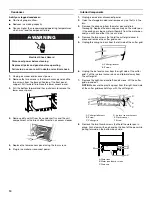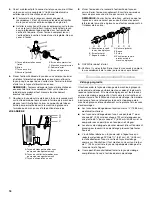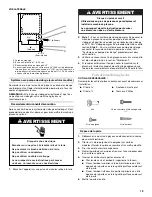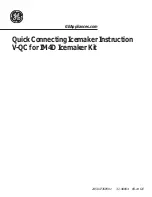
5
■
Allow the storage tank on the reverse osmosis system to refill
after heavy usage.
If you have questions about your water pressure, call a licensed,
qualified plumber.
Leveling
It is important for the ice maker to be level in order to work
properly. Depending upon where you install the ice maker, you
may need to make several adjustments to level it. You may also
use the leveling legs to lower the height of the ice maker for
undercounter installations.
Tools needed:
Gather the required tools and parts before starting installation.
■
9" level
■
Adjustable wrench
NOTE: It is easier to adjust the leveling legs if you have another
person to assist you.
1. Move the ice maker to its final location.
NOTE: If this is a built-in installation, move the ice maker as
close as possible to the final location.
2. Place a carpenter’s level on top of the product to see if the ice
maker is level from front to back and side to side.
3. Push up on the top front of the ice maker, and then locate the
leveling screws that are on the bottom front of the ice maker.
4. Using an adjustable wrench, change the height of the legs as
follows:
■
Turn the leveling leg to the right to lower that side of the
ice maker.
■
Turn the leveling leg to the left to raise that side of the ice
maker.
NOTE: The ice maker should not wobble. Use shims to add
stability when needed.
5. Push up on the top rear of the ice maker and locate the
leveling legs that are on the bottom rear of the ice maker.
6. Follow the instructions in Step 4 to change the height of the
legs.
7. Use a carpenter’s level to recheck the ice maker to see that it
is even from front to back and side to side. If the ice maker is
not level, repeat steps 2 to 5. If the ice maker is level, go to
the “Connect Water Supply” section.
Connect Water Supply
Read all directions thoroughly before you begin.
IMPORTANT:
■
Plumbing shall be installed in accordance with the
International Plumbing Code and any local codes and
ordinances.
■
Use copper tubing and check for leaks.
■
Install copper tubing only in areas where temperatures will
remain above freezing.
Tools needed:
Gather the required tools and parts before starting installation.
Read and follow the instructions provided with any tools listed
here.
■
Flat-blade screwdriver
■
⁷⁄₁₆
" and
¹⁄₂
" open-end wrenches or two adjustable wrenches
■
¹⁄₄
" nut driver
■
¹⁄₄
" drill bit
■
Hand drill or electric drill properly grounded
NOTE: Your ice maker dealer has a kit available with a
¹⁄₄
"
(6.35 mm) saddle-type shutoff valve, a union, and copper tubing.
Before purchasing, make sure a saddle-type valve complies with
your local plumbing codes. Do not use a piercing-type or
³⁄₁₆
"
(4.76 mm) saddle valve which reduces water flow and clogs more
easily.
Connecting the water line
1. Turn off main water supply. Turn on nearest faucet long
enough to clear line of water.
2. Find a
¹⁄₂
" (12.70 mm) to 1
¹⁄₄
" (3.18 cm) vertical cold water
pipe near the ice maker.
NOTE: Horizontal pipe will work, but the following procedure
must be followed: Drill on the top side of the pipe, not the
bottom. This will help keep water away from the drill. This
also keeps normal sediment from collecting in the valve.
3. Using a grounded drill, drill a
¹⁄₄
" (6.35 mm) hole in the cold
water pipe you have selected.
4. Fasten shutoff valve to cold water pipe with pipe clamp. Be
sure outlet end is solidly in the
¹⁄₄
" (6.35 mm) drilled hole in the
water pipe and that the washer is under the pipe clamp.
Tighten packing nut. Tighten the pipe clamp screws carefully
and evenly so washer makes a watertight seal. Do not
overtighten the pipe clamp or you may crush cold water pipe
if it is soft copper tubing. Do not use a piercing-type or
³⁄₁₆
"
(4.76 mm) saddle-type valve which reduces water flow and
clogs more easily.
5. Now you are ready to connect the copper tubing. Use
¹⁄₄
"
(6.35 mm) OD soft copper tubing for the cold water supply.
■
Ensure that you have the proper length needed for the
job. Be sure both ends of the copper tubing are cut
square.
■
Slip compression sleeve and compression nut on copper
tubing as shown. Insert end of tubing into outlet end
squarely as far as it will go. Screw compression nut onto
outlet end with adjustable wrench. Do not overtighten.
6. Place the free end of the tubing into a container or sink, and
turn on main water supply and flush out tubing until water is
clear. Turn off shutoff valve on the water pipe.
NOTE: Always drain the water line before making the final
connection to the inlet of the water valve to avoid possible
water valve malfunction.
7. Bend the copper tubing to meet the water line inlet which is
located on the back of the ice maker cabinet as shown.
Leave a coil of copper tubing to allow the ice maker to be
pulled out of the cabinet or away from the wall for service.
A. Cold water pipe
B. Pipe clamp
C. Copper tubing
D. Coupling (purchased)
E. Compression nut
F. Compression sleeve
G. Shutoff valve
H. Packing nut
A
B
C
D
E
F
G
H






































